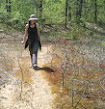 photo by Martha Macy
photo by Martha Macy
The only elm tree I’ve ever seen is the American Elm in front of the Manulife Insurance building on Bloor Street.
I have to admit, it's an impressive and elegant bit of marketing for an insurance company. The tree was planted in 1934 and Dutch elm disease hit Ontario in the 60's, so I don't know how they've pulled it off; although when it came up at a
Drug-addled or otherwise, turns out that tree isn't as lonely as I thought. Apparently 1,600 surviving White or American Elm trees have been reported across
This is what I'm reading in two recent articles by Sharon Oostenhoek: "One Night Stands" in Ontario Nature magazine's Winter 2007 issue and "A dating service for lonely elms" in yesterday's Globe and Mail.
Problem is, these elms are too far apart to breed with each other. That’s where
If you have an elm to report or just want to know more about U of Guelph's work, check out their Elm Recovery Project.
When you look at the range of the Butternut you'll see it's one of our native Southern Ontario "Carolinian" forest trees.
You can still buy a native butternut tree at Acorus Restoration. Visit their online catalogue and you'll read: "the Butternut tree has come under threat. A disease has killed most mature specimens and some trees are showing resistance. We must plant more to keep finding resistant genes.”
You can find more info and other ways to help out Butternut conservation efforts at the Forest Gene Conservation Association's information on butternut and the butternut canker in Canada.


2 comments:
RIP - this Elm is slated for removal Jan 19, 2013. It contracted Dutch Elm Disease in 2012, and wasn't able to be saved.
So sad... that tree was so beautiful and I enjoyed seeing it every day....
Post a Comment